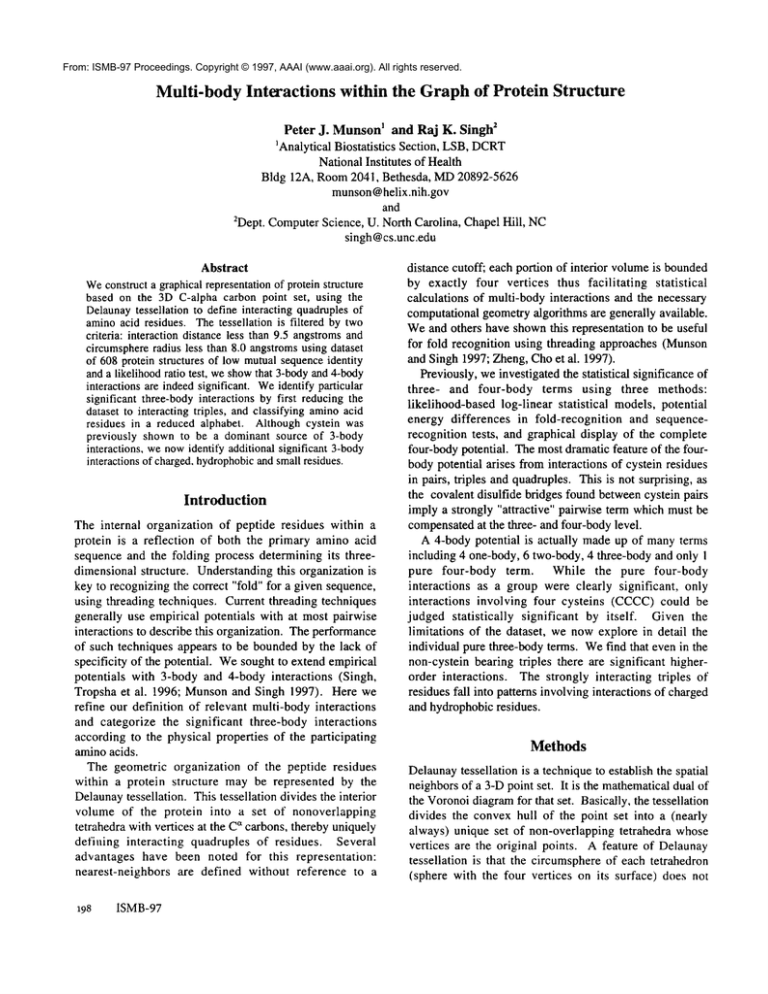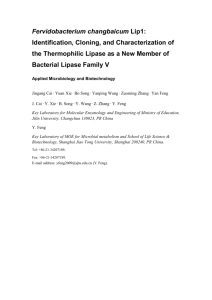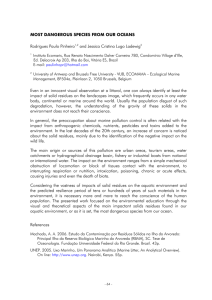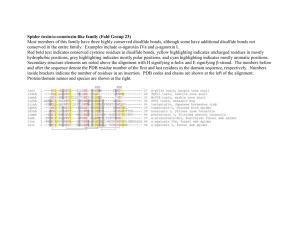
From: ISMB-97 Proceedings. Copyright © 1997, AAAI (www.aaai.org). All rights reserved.
Multi-body Intwactions within the Graphof Protein Structure
I ~
Peter J. Munson
and Raj K. Singh
~Analytical Biostatistics Section, LSB,DCRT
National Institutes of Health
Bldg 12A, Room2041, Bethesda, MD20892-5626
munson@helix.nih.gov
and
2Dept. ComputerScience, U. North Carolina, Chapel Hill, NC
singh@cs.unc.edu
Abstract
Weconstruct a graphicalrepresentationof protein structure
based on the 3D C-alpha carbon point set, using the
Delaunaytessellation to define interacting quadruplesof
aminoacid residues. The tessellation is filtered by two
criteria: interaction distance less than 9.5 angstromsand
circumsphereradius less than 8.0 angstromsusing dataset
of 608protein structures of lowmutualsequenceidentity
and a likelihood ratio test, weshowthat 3-bodyand 4-body
interactions are indeedsignificant. Weidentify particular
significant three-bodyinteractions by first reducingthe
dataset to interacting triples, and classifying aminoacid
residues in a reduced alphabet. Althoughcystein was
previously shownto be a dominant source of 3-body
interactions, wenowidentity additional significant 3-body
interactions of charged,hydrophobic
andsmall residues.
Introduction
The internal organization of peptide residues within a
protein is a reflection of both the primary amino acid
sequence and the folding process determining its threedimensional structure. Understandingthis organization is
key to recognizing the correct "fold" for a given sequence,
using threading techniques. Current threading techniques
generally use empirical potentials with at most pairwise
interactions to describe this organization. The performance
of such techniques appears to be bounded by the lack of
specificity of the potential. Wesought to extend empirical
potentials with 3-body and 4-body interactions (Singh,
Tropsha et al. 1996; Munsonand Singh 1997). Here we
refine our definition of relevant multi-body interactions
and categorize the significant three-body interactions
according to the physical properties of the participating
aminoacids.
The geometric organization of the peptide residues
within a protein structure may be represented by the
Delaunaytessellation. This tessellation divides the interior
volume of the protein into a set of nonoverlapping
tetrabedra with vertices at the C~ carbons, thereby uniquely
defining interacting quadruples of residues. Several
advantages have been noted for this representation:
nearest-neighbors are defined without reference to a
198
ISMB-97
distance cutoff; each portion of interior volumeis bounded
by exactly four vertices thus facilitating statistical
calculations of multi-body interactions and the necessary
computationalgeometryalgorithms are generally available.
Weand others have shownthis representation to be useful
for fold recognition using threading approaches (Munson
and Singh 1997; Zheng, Cho et al. 1997).
Previously, we investigated the statistical significance of
three- and four-body terms using three methods:
likelihood-based log-linear statistical models, potential
energy differences in fold-recognition and sequencerecognition tests, and graphical display of the complete
four-bodypotential. The most dramatic feature of the fourbodypotential arises from interactions of cystein residues
in pairs, triples and quadruples. This is not surprising, as
the covalent disulfide bridges found betweencystein pairs
imply a strongly "attractive" pairwise term which must be
compensatedat the three- and four-bodylevel.
A 4-body potential is actually made up of manyterms
including 4 one-body, 6 two-body,4 three-body and only I
pure four-body term. While the pure four-body
interactions as a group were clearly significant, only
interactions involving four cysteins (CCCC)could
judged statistically
significant by itself. Given the
limitations of the dataset, we nowexplore in detail the
individual pure three-body terms. Wefind that even in the
non-cystein bearing triples there are significant higherorder interactions. The strongly interacting triples of
residues fall into patterns involvinginteractions of charged
and hydrophobicresidues.
Methods
Delaunaytessellation is a techniqueto establish the spatial
neighbors of a 3-D point set. It is the mathematicaldual of
the Voronoidiagramfor that set. Basically, the tessellation
divides the convex hull of the point set into a (nearly
always) unique set of non-overlapping tetrahedra whose
vertices are the original points. A feature of Delaunay
tessellation is that the circumsphereof each tetrahedron
(sphere with the four vertices on its surface) does not
contain any other points in the set. The edges of the
resulting tetrahedra connect pairs of vertices which are
"nearest-neighbors".
Groups of four vertices in a
tetrahedron are considered a clique in the connection
graph for the point set and are available for analysis of the
four-body and lower-order interactions. The tessellation
can be efficiently calculated with available software
(Barber, Dobkinet al. 1995).
In applying this technique to protein structures, we
represent the protein as simply a 3-D point set with one
point placed at the center of each C~ carbon. More
complexrepresentations (points at the ~ carbon, or o ther
representative atoms, etc.) have beentried, but do not make
a substantial difference for the current purposes. Clearly, a
more detailed representation of the protein can be useful
for protein threading-fold recognition. To make the
tessellation more representative of actual interactions
within proteins, we employed a filtering
technique
described elsewhere (Munsonand Singh 1997). Basically
tetrahedra with any edges are greater than 9.5,~ or with
circumsphereradius greater than 8.0/tL are rejected. This
eliminates about half of the original tetrahedra, which
generally lie outside the water-accessible surface of the
protein.
For this study we tessellated a dataset of 608 protein
chains of knownstructure having less than 35%pairwise
sequence identity and a resolution of less than 3.0 ,/~
(Hobohmand Sander 1994).
The frequencies of observed tetrahedra, labeled by the
standard 20-letter amino acid residue code, are arranged
into a 20x20x20x20 table and form the basis for our
analyses. Weuse a log-linear statistical modelto represent
the natural logarithm of the frequencies as a sum of zeroth, first-, second, third and fourth order terms. Thefull 4body modelis:
In m4kl =Iu +u~+uj+uk+u
1-bodyeffects
+u~+utt+u~+uk+uj~+u~t
2-body interaction
+u~jk+u~:t+uoa+ujn 3-body interaction
+uijks
4-bodyinteraction
wherethe predicted frequencies mow,are subject to the
symmetryconstraint (mukt = m~j~)for all 24 permutations
¢~ ). This modeland all hierarchical submodelsare
estimated using the maximum
likelihood iterative
proportional fitting algorithm(Bishop, Fienberget al.
1975) programmedin MATLAB
(The Mathworks, Inc.,
Natick, Mass., USA).Log likelihood differences (A’s)
between models are comparedto the difference in number
of parametersfor two models,and the result is given as a
Z-score, Z = (2A log likelihood - Adf) I ~--~,
where df is the degrees
of freedom or number of
parameters associated with each model. This statistic is
asymptotically distributed as a standard normalvariate and
can be used to judge the significance of a high-order model
comparedto a lower-order model. Absolute values greater
than 3.3 correspondto P-values of about 0.001 or less.
The potential energy associated with any particular
assignmentof residues to the four tetrahedral vertices is
estimated
from the modeled frequencies
as
Eijkl
=-lnIrn~kl l NPiPjPkPlI where the p, are the
proportion of residue type i in the database. Full graphical
displays of the 20x20x20x20=160,000 terms in the
potential have been presented elsewhere (Munson and
Singh 1997). Componentsof the potential energy can be
obtained by referring to the appropriate u term of the loglinear model.
Because manyof the observed or expected frequencies
are quite low (average observed frequency is about 50 per
cell), some of the energy components are unreliably
estimated. Thus, judging the true significance of individual
components may be problematic. To account for this
sparse data, we have also calculated the Freeman-Tukey
residual ((Bishop, Fienberg et al. 1975), p 136) which
combinesobserved, x, and predicted, m, frequencies into a
statistic of approximatelyunit variance regardless of the
small frequencies. It is z = "~ + ~ - ~/4m + 1.
Invoking the permutabiiity assumption, we sum over all
distinct permutationsof the subscripts for the observedand
expected frequencies, yielding a smaller number (8,855
rather than 160,000) of categories and larger average
frequencies.
To find patterns in the three-body terms, a 3-waytable
of the frequenciesof triangles in the original tessellation is
required. A three-way table is obtained by summingone of
the factors of the four-way table. Thus, the expected
numberm~jk of triangles with vertices i,j,k is given by
3 4.~m4
mijk = 2 1=1 tjkl,
where the factor 4 arises since there are four triangular
faces on each tetrahedron, and the factor 2 since each
triangle is present in approximately2 tetrahedra; those on
the surface are present in only one. Invoking
permutability, we can again condense 8,000 categories to
1330. The observed and expected frequencies for triangles
can be studied with the methodsgiven above. Still further
reduction is obtained by recoding the standard 20 letter
amino acid residue code as follows: hydrophobic
"h"= { A,F,I,L,M,V,W,Y
}, positively charged"+" = { K,R },
negatively charged "-"={D,E,N,Q}, small "s"={P,S,T}.
Other residues C, G, H were not recoded.
Munson
........................
.....................................................
.......................................................................................................................................................................................................................................
~99
Results
& Discussion
Wehad previously established the presence of higher-order
(greater than 2-body) interactions in the frequency
tetrahedra in tessellated proteins (Munsonand Singh 1997).
Oneline of evidence is repeated in Table 1 for a refined
dataset (morestringent filtering of the original tessellation,
see Methods). The hierarchical comparison of the threebody model to the two-body model yields a Z-score of 54,
which is extremely significant. The comparison of the 4to the 3-body model yields a Z-score which is significant
(moreso than previously reported), but still uncomfortably
close to the usual cutoff (121>3.1). Nevertheless, with 32%
of the total log-likelihood or information from all the
multibody terms (2,3, and 4), the 4-body term seems
makean important contribution.
Table 1. Hierarchical
Comparison
1 vs 0
2 vs 1
3 vs 2
4 vs 3
Comparison of Models.
A logLikelihood
-18676
-12904
-2059
-3947
Adf
19
190
1330
7315
Z-score
6056
1314
54
4.8
Wepreviously sought important pure 4-body interactions
responsible for the significance of the 4-body vs 3-body
comparison. (Munson and Singh 1997). Only the 4-body
term associated with the quadruple CCCCwas clearly
significant. Multibodyinteractions involving cystein arise
from the ability of C to form covalently linked pairs. Such
pairs imply a very strong pairwise term, which contribute
to all six pairs of edges in a tetrahedra and thereby overpredict the occurrences of CCCand CCCC.
To look beyond this group of effects, we removedall
tetrahedra with C at any of their vertices. Of the original
385,161 tetrahedra, 355,500 remained. Repeating the
analysis of significance of the high-order models shows
(Table 2) that both the three- and four-body components
remainsignificant (Z-score = 38 and 4, resp.), although the
Z-score values are noticeably reduced. Thus, even after C
is removedfrom the analysis, there appears to be highorder interactions.
Table 2. Hierarchical
Removing Cystein
Comparison
1 vs 0
2 vs 1
3 vs 2
4 vs3
200
Comparison of Models after
A logLikelihood
-17053
-7077
-1476
-3190
ISMB-97
A df
18
171
1140
5985
Z-score
5681
756
38
4
To investigate for significant three-bodyinteractions, we
reducedour dataset from a tetrahedral representation to one
embodyingonly triangles of residues. Accordingly, we
computeda three-waytable of the frequencies of all triples
(triangles in the original tessellation) of residues (see
Methods).Fromthe original filtered tessellation, we found
about 770,300 triangles. The three-way table showed a
strongly significant three-body component (Z=18.6).
Whencystein-containing triangles were dropped (yielding
711,000 triangles), the three-body Z-score droppedto 8.5,
but wasstill highly significant.
After dropping the C residues, the set of Freeman-Tukey
residuals (versus two-body predictions) were ranked,
yielding a list of 1,140 values (all distinct combinationsof
19 letters), the most over-represented triples were DRV,
EKL, EKV, AER, DFK, all examples of an oppositely
charged pair with a hydrophobicresidue. At the bottom of
the list we find a more heterogeneous group: GMR,DER,
ELV,NQR,EEK.To find commonpatterns in this list, we
re-expressed the 20 letter aminoacid code into a reduced
alphabet (see Methods). Wethen looked for consistent
patterns of residue types in the top 40 and the bottom 40
Freeman-Tukeyresiduals.
Six patterns emergedfrom this analysis (Table 3). The
first pattern (+ - h) involves oppositely charged pairs with
hydrophobic residues. This pattern produced the largest
positive value of any residual (rank 1), and had a total
13 membersin the top 40. Taking all 64 membersof the
group together, the average tendency was significantly
positive (Student’st statistic value = 5.8), indicating that
a group the (+ - h) pattern was significant. Three-body
interactions between oppositely charged residues and a
hydrophobic have been observed (Godzik, Kolinski et al.
1992; Godzik and Skolnick 1992; Munson and Singh
1997).
Interestingly, the pattern (- - h) also appeared with
significant positive three-body interaction. However,the
pattern (+ + h) did not appear in any of the top 40 residuals.
The pattern (+/- h s) appeared5 times in the top 40 and had
a significant t-value overall.
For the underrepresented patterns, the most striking
pattern involves three charged residues (+ - - ) or (+ +
Almostas important are the two groups (- h h) and (+ h
involving a single charge with two hydrophobics.It should
be noted that the hierarchical statistical modelcreates the
situation where these various patterns maybe linked: a
large positive interaction in the modelfor one cell, say, for
a (+ - h) pattern, implies that other interactions must
negative, in order that the sum of three-body interactions
be zero. Thus, the patterns involving hydrophobic and
charged residues are obviouslyinterrelated.
Whatis clearly new in this analysis is the following.
Significant three-body interactions remain after removing
the maskingeffect of cystein interactions. Not only do the
previously identified oppositely charge pair-hydrophobic
interactions emergeas significant, but a strong tendencyis
identified for similarly-charged pair and hydrophobic
triples to cluster. These interactions are balanced by
significant anti-clustering for charged residue triples, or
single charged residues with two hydrophobicresidues.
Within each of the general patterns, there is clearly
heterogeneity as some (+ - h) members(DRVfor example)
produce a muchmore positive residual than others. Some
membersactually underrepresented (for example ERF).
Precisely how these residue combinations interact in
protein structures remainsto be explained fully.
Finally, we offer an explanation for the interaction terms
involving charged and hydrophobic residues.
The
paradoxical clustering of a charged pair with a hydrophobic
residue must be interpreted in the context of the pairwise
co~oponents acting on this same set. There are three
pairwise components(one negative, two positive in this
instance) and three one-body componentsto consider as
well. Thus, the pure three bodyterm is really a correction
added to the otherwise largely repulsive pairwise terms
between the hydrophobic and the charged residues.
Table 3. Prominent3-body Interactions not Involving
Cystetn
Pattern* and
Top Group Group
Membersin Top or Bottom 40
rank size t-value
Over-represented(positive interaction)
(+ - h)
1
64
DRV,EKL,EKV,AER,DFK,AQR,
EIICERV,DLR,EIR,DIK,ELR,LNR
(+/- h s)
8
96
ADP, MRT,QSV, KLP, EFT
80
(- - h)
9
DEI,NNV,NQV,DEV,EIN,DDM
Under-represented(negative interaction)
2
20
(+. - ) or ( + +
DER,NQR,EEK,DDK,KNN,DEK
3
144
(- h h)
ELV, LNV,IQV, EIV, AEV
11 72
(+ h h)
ILR,FIK,ARV,KLV,KLM,IKL,MRW
5.8
2.8
4.2
-4.4
-4.8
-2.4
*See Methodsfor reduced alphabet in patterns.
Three-body terms may arise partly as a consequence of
the permutability assumption. A logical consequence of
that assumption is that the modeldoes not distinguish any
individual vertex position in the graph; all positions are
assumedto have the identical distribution on the set of 20
residues. In reality, the presence of a surface boundary
implies that somevertices are special; they lie on the
solvent accessible surface and are muchmore likely to be
occupied by charged residues, while other vertices are
more likely to be occupied by hydrophobic residues.
Dependingon the geometric arrangement of residues near
the surface, pairs of charged residues, likely to lie on the
surface, may also be likely to interact with a buried
hydrophobic neighbor. Multi-body interactions also arise
whenspecial relationships (covalent bondingof C-Cpairs
but not of triples or quadruples), are present. Advancing
the statistical description of the protein structure clearly
requires inclusion of this detailed information.
For now, it is clear that manythreading methodswhich
look primarily at two-bodyinteractions are missing about
50%of the available information in these higher-order
interactions. Here, we have confirmed the existence of
high-order interactions on a large dataset, and identified
two major sources of these interactions:
cystein
interactions and hydrophobic-charge combinations. The
power of protein threading methods which use pairwise
pseudopotentials would surely be enhanced if such
multibodyinteractions were incorporated.
References
Barber, C. B.; Dobkin, D. P. and Huhdanpaa,H. T. 1995.
The Quickhull Algorithm for Convex Hulls. ACM:Trans.
on Mathematical Software, Forthcoming.
Bishop, Y. M. M.; Fienberg, S. E. and Holland, P. W.
1975. Discrete Multivariate Analysis: Theoryand Practice.
Cambridge: The MITPress.
Godzik, A.; Kolinski, A. and Skolnick, J. 1992. Topology
Fingerprint Approach to the Inverse Protein Folding
Problem. J Mol Bio1227: 227-283.
Godzik, A. and Skolnick, J. 1992. Sequence-structure
matching in globular proteins:
Application
to
supersecondaryand tertiary structure determination. Proc
Natl Acad Sci USA89: 12098-12102.
Hobohm,U. and Sander, C. 1994. Enlarged representative
set of protein structures. Protein Science 3: 522-524.
Munson,P. and Singh, R. 1997. Statistical Significance of
Hierarchical Multi-body Potentials Based on Delaunay
Tessellation and their Application in Sequence-Structure
Alignment. Protein Science Forthcoming.
Singh, R. K.; Tropsha, A. and Vaisman, I. I. 1996.
Delaunay Tessellation of Proteins: Four-body Nearestneighbor Propensities of Amino-acidResidues. J CompBio
3: 213-221.
Zheng, W. et al. 1997. A new approach to protein fold
recognition based on Delaunay tessellation of protein
structure. In Pacific Symposiumon Biocomputing ’97,
Maui, Hawaii, USA,World Scientific Publishing Co. Pte.
Ltd.
Munson
2Ol







